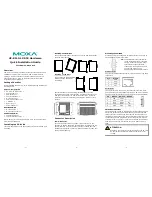
16
2.3 Cable Installation and Splicing
Cable placement procedures vary with individual installations. In general, however, all
installations have in common the following requirements:
1)
The cable must be protected from damage by angular particles of the material in which the
cable is embedded.
2)
The cable must be protected from damage by compaction equipment.
3)
In earth and rock embankments and backfills, the cable must be protected from stretching as
a result of differential compaction of the embankment.
4)
In concrete structures, the cable must be protected from damage during placement and
vibration of the concrete.
In embankments, cables may be embedded in a protective covering of sand or selected fine
embankment materials. A typical installation might, for example, comprise the positioning of a
series of cables on a prepared layer consisting of not less than 200 mm (8") of compacted
selected fine material. In order to establish an acceptable grade without undue interference with
construction operations, the prepared layer may be located either in a trench or on an exposed
ramp. In rockfill dams with earth fill cores, for example, it is frequently convenient to install
cable in trenches in the core and fine filter zones, and in ramps in the coarse filter and compacted
rockfill shell zones. Individual cables should be spaced not less than 12 mm (0.5") apart, and no
cable should be closer than 150 mm (6") to the edge of the prepared layer. In instances in which
cables must cross each other, or in which more than one layer of cables must be placed in a given
array, the cables should be separated from each other by a vertical interval of not less than 50
mm (2") of hand compacted sand or selected fine embankment material. Since the elongation
capability of electrical cable is quite substantial, it is not necessary to install the cable with any
"S" shaped meanders.
During the backfill of trenches in earth dams, a plug, approximately half a meter (two feet) in
width, made of a mixture of 5% bentonite (by volume) from an approved source and exhibiting a
free swell factor of approximately 600%, and 95% embankment material, can be placed in the
trenches at intervals of not greater than 20 meters (50 feet). The purpose of the bentonite plugs is
to reduce the possibility of water seepage through the embankment core along the backfilled
trenches.
The cable may be marked by using a Mylar cable labels. For an individual cable, the
identification number should be taped near the end of the cable. Additional cable labels can be
specified to aid in identification if cables need to dug up for splicing, etc.
Splice kits recommended by Geokon incorporate casts, which are placed around the splice and
are then filled with epoxy to waterproof the connections. When properly made, this type of splice
is equal or superior to the cable in strength and electrical properties. Contact Geokon for splicing
materials and additional cable splicing instructions.
Cables may be terminated by stripping and tinning the individual conductors and then connecting
them to the patch cord of a readout box. Alternatively, a connector may be used which will plug
directly into the readout box or to a receptacle on a special patch cord.
Содержание 4800 Series
Страница 2: ......
Страница 4: ......
Страница 30: ...24 Figure 18 Sample Model 4800 Calibration Sheet ...
















































